Macrolepiota excoriata (Schaeff.: Fr.) Wass.
Phylum: Basidiomycota - Class: Agaricomycetes - Order: Agaricales - Family: Agaricaceae
Distribution - Taxonomic History - Etymology - Identification - Culinary Notes - Reference Sources
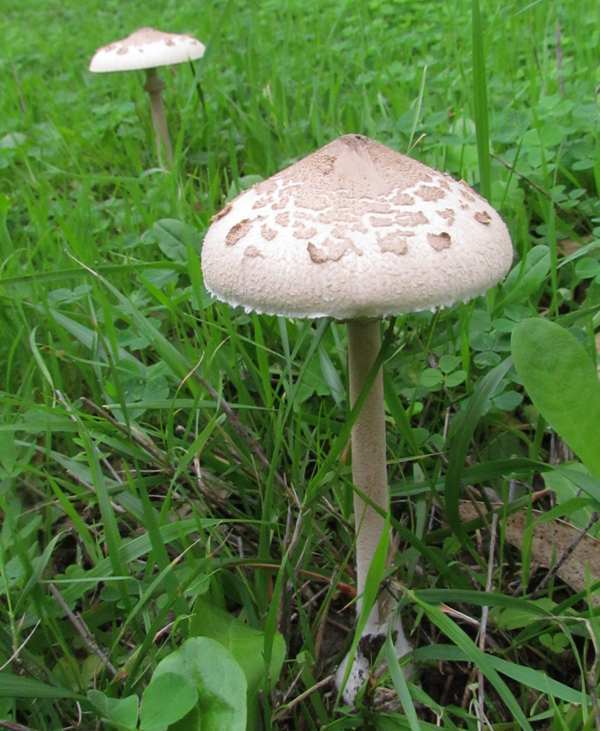
Macrolepiota excoriata is in many respects a miniature lookalike of the Parasol Mushroom, Macrolepiota procera. Like its larger cousin, this is an edible mushroom but much too scarce to be a serious target for commercial pickers.
As it so often occurs on roadside verges, where soil may have become contaminated by exhaust fumes or oil spills, this attractive mushroom is best left undisturbed for other passers by to enjoy. (Specimens collected from fields and other open grassland areas are good to eat, however.)
Distribution
Infrequent in southern Britain and Ireland, and even less common in northern England and Scotland, Macrolepiota excoriata occurs also in many countries of central and southern mainland Europe and in parts of North America.
The specimens shown here were photographed on 18th December 2012 in the Algarve region of southern Portugal.
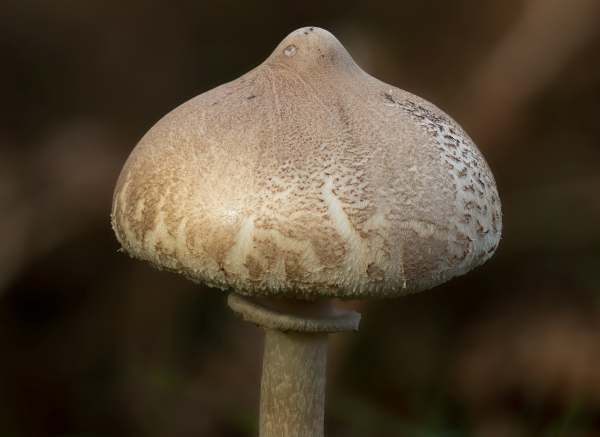
Taxonomic history
Originally described in 1762 by Jacob Christian Schaeffer, who named it Agaricus excoriatus (most gilled fungi were placed initially in a gigantic Agaricus genus in those days), this mushroom was given its present scientific name by Ukrainian mycologist Solomon P Wasser (born 1946) in 1978.
Synonyms of Macrolepiota excoriata include Agaricus excoriatus Schaeff., Lepiota excoriata (Schaeff.) P. Kumm., Leucocoprinus excoriatus (Schaeff.) Pat., Leucoagaricus excoriatus (Schaeff.) Singer, Leucocoprinus heimii Locq., Lepiota heimii (Locq. ex Bon) Contu, and Macrolepiota heimii Locq. ex Bon, Boll.
Etymology
The specific epithet excoriata refers to the way that the scales draw away from (excoriate) the margin of the cap.
Several former members of the Macrolepiota genus are now sited in the genus Chlorophyllum, which contains some large parasol-like fungi that are now known to be toxic to many people - for example Chlorophyllum rhacodes, the Shaggy Parasol, which used to be known by the scientific name Macrolepiota rhacodes.
Identification guide
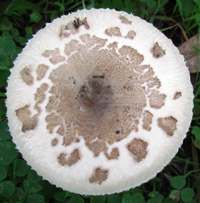 |
CapInitially hemispherical, becoming broadly convex with a small umbo, the cap surface is very pale brown with large brown scales and an intact brown central zone that is darkest over the umbo The cap flesh is almost white and does not change colour significantly when cut. Cap diameter at maturity ranges between 5 and 9cm. |
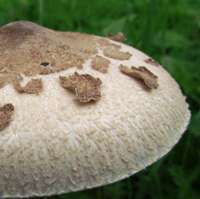 |
The outer scales are irregular, large, and have upturned edges; there are no scales at the margin, which usually remains slightly downturned. |
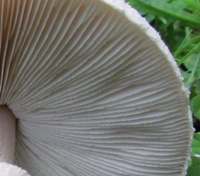 |
GillsThe broad, crowded gills of Macrolepiota excoriata are creamy white and free, terminating close to the stem. Gill edges are finely floccose. |
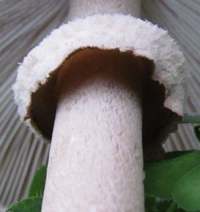 |
StemA large single pendent floccose ring with a narrow brown margin persists around the stem of Macrolepiota excoriata but often becomes movable on old specimens and sometimes falls towards the base. The stem surface is fairly smooth, pale cream with a slight pinkish tinge and finely velutinous below the ring. Inside the stem the tough white fibrous flesh is loosely packed and initially solid, sometimes becoming hollow with age. Noticeably swollen at the base, the stems of Macrolepiota excoriata are cylindrical over most of their length; the diameter ranges from 0.7 to 1cm (expanding to 2cm across the bulbous base), and the stem height can be up to 14 cm. |
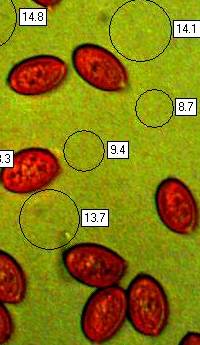 |
SporesEllipsoidal, smooth, thick-walled; 13-18 x 8-10µm; with a small germ pore; dextrinoid. Spore printWhite or pale cream. |
Odour/taste |
Faint odour and taste are pleasant but not distinctive. |
Habitat & Ecological role |
Saprobic, uncommon and mainly found on roadside verges (often on poor sandy soils), in permanent pastures, and in grassy areas next to woodland, growing alone or in small trooping groups; also reported occasionally from stable grass-covered sand dunes. |
Season |
August to November in Britain and Ireland; later in the year in southern Europe. |
Similar species |
Chlorophyllum rhacodes, the Shaggy Parasol, is stockier than Macrolepiota and it has a smooth stem. Macrolepiota procera, the Parasol, is larger and has a snakeskin pattern on its stem. |
Culinary Notes
If you gather these lovely mushrooms to eat, be aware that the somewhat similar Shaggy Parasol, Chlorophyllum rhacodes, can cause tummy upsets. The Shaggy Parasol has flesh that turns red when it is cut, and its stem lacks the velutinous texturing below the stem ring.
Reference Sources
Fascinated by Fungi, 2nd Edition, Pat O'Reilly 2016, reprinted by Coch-y-bonddu Books in 2022.
Dictionary of the Fungi; Paul M. Kirk, Paul F. Cannon, David W. Minter and J. A. Stalpers; CABI, 2008
Taxonomic history and synonym information on these pages is drawn from many sources but in particular from the British Mycological Society's GB Checklist of Fungi.
Acknowledgements
This page includes pictures kindly contributed by David Kelly.
Fascinated by Fungi. Back by popular demand, Pat O'Reilly's best-selling 450-page hardback book is available now. The latest second edition was republished with a sparkling new cover design in September 2022 by Coch-y-Bonddu Books. Full details and copies are available from the publisher's online bookshop...

